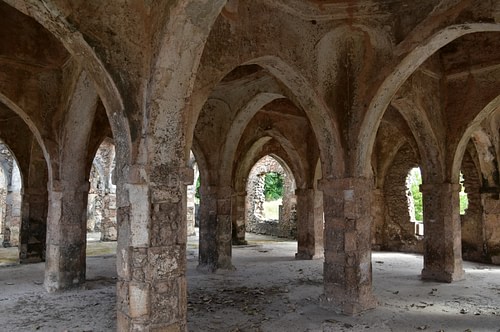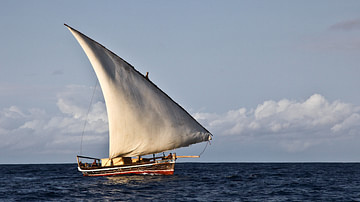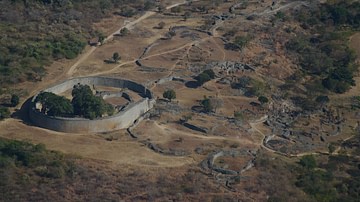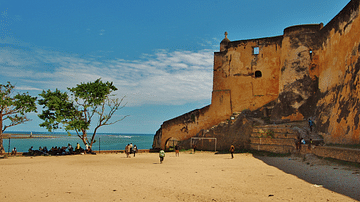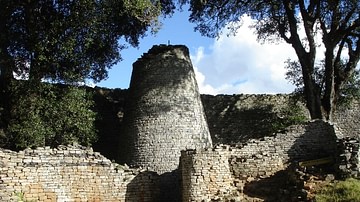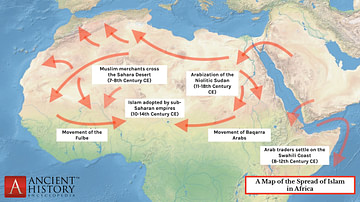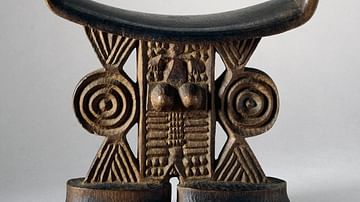
Kilwa, an island located off the coast of East Africa in modern-day southern Tanzania, was the most southern of the major Swahili Coast trading cities that dominated goods coming into and out of Africa from and to Arabia, Persia, and India. Kilwa flourished as an independent city-state from the 12th to 15th century CE largely thanks to the great quantity of gold coming from the kingdom of Great Zimbabwe to Kilwa's southern outpost of Sofala. Kilwa boasted a huge palace complex, a large mosque, and many fine stone buildings at its peak in the 14th century CE. The arrival of the Portuguese in the early 16th century CE spelt the beginning of the end of Kilwa's independence as trade declined and merchants moved elsewhere.
The Swahili Coast
The term Swahili Coast refers the stretch of coastline along East Africa from Mogadishu in Somalia at its northern end to the Kilwa in the south. Major ports and towns in between, over 35 in total, included Vrava, Pate, Kismayu, Malindi, Mombassa, Pemba, Zanzibar, and Mafia. In addition to these main sites, there are some 400 other smaller ancient sites dotted along the eastern coastal area. The term Swahili derives from the Arabic word sahil ('coast') and so means 'people of the coast'. It not only refers to the coastal region but also to the language spoken there, a form of Bantu which emerged in the middle of the 1st millennium CE. Later, many Arabic terms were mixed in and Swahili became the lingua franca of East Africa, even if different dialects did develop. The language is still spoken today in East Africa and is the national language of Kenya and Tanzania.
Swahili coast peoples prospered thanks to agriculture and animal husbandry, aided by a regular annual rainfall and shallow coastal waters plentiful in seafood. Trade, conducted by sailing vessels, first began up and down this coast between the Bantu farming peoples living there in the first centuries of the 1st millennium CE during the region's Iron Age. Sea travel was aided by the long lines of coral reefs which protect the shallow calmer waters between them and the coastline, as well as coastal islands which provided both shelter and handy stopping-off points en route. In addition, the coast of East Africa provides many natural harbours formed by submerged former river estuaries.
Initially inhabiting the interior, Bantu people had gradually moved to the coast as the second half of the first millennium CE wore on, creating new settlements and using stone - typically coral blocks held together with mortar - instead of, or in addition to, mud and wood for their homes. They profitably traded coastal commodities such as shell jewellery for agricultural products from the more fertile interior. When trade networks spread along the coast, so too ideas in art and architecture went with them, as did language, spreading Swahili further afield.
A Meeting of Two Worlds
From the 7th century CE, trade networks expanded to include the Red Sea (and so Cairo in Egypt), and then Arabia and the Persian Gulf. Arab dhows with their distinctive triangular sails filled the ports of the Swahili coast. Trade was even carried on across the Indian Ocean with India and Sri Lanka, as well as China and Southeast Asia. The long-distance sea voyages were made possible by the alternation of winds which blew to the northeast in the summer months and reversed in the winter months.
From the mid-8th century CE, Muslim traders from Arabia and Egypt began to permanently settle in towns and trading centres along the Swahili coast. The Bantu and Arabs mixed, as did their languages, with intermarrying being common and a blending of cultural practices which led to their evolution into a unique Swahili culture.
Shirazi merchants from the Persian Gulf arrived at Kilwa from the 12th century CE and so the influence of the Sunni Islamic religion and Muslim architecture was further strengthened. The Shirazi established their rule over Kilwa by around 1200 CE - by peaceful means according to medieval Arab sources - although the city-state did not exert any form of wider political control or even cultural influence over the mainland interior. As Kilwa could not produce its own food, though, there must have been some arrangement with local tribes on the mainland.

The social structure of Kilwa and other Swahili ports is here summarised by the historian H. Neville Chittick:
The inhabitants of the towns can be considered as falling into three groups. The ruling class was usually of mixed Arab and African ancestry…such also were probably the landowners, merchants, most of the religious functionaries and the artisans. Inferior to them in status were the pure-blooded Africans, probably mostly captured in raids on the mainland and in a state of slavery, who cultivated the fields and no doubt carried out other menial tasks. Distinct from both these classes were the transient or recently settled Arabs, and perhaps Persians, still incompletely assimilated into the society. (Fage, 209)
The population of Kilwa at its peak was likely at least 10,000 residents, perhaps double that figure. It was governed by a single ruler, but details of how he was chosen are lacking besides some cases of one ruler nominating his successor. Assisting the ruler or sultan were various officials, such as a council of advisors and a judge, who were all likely selected from the most powerful merchant families.
Kilwa's ability to attract foreign interest continued into the 15th century CE. In 1417 CE the famed Chinese admiral Zheng He (1371-1433 CE) made it to East Africa in one of his celebrated seven voyages of exploration. Zheng He took back to China such exotica as giraffes, gems, and spices. Foreign travellers and the accounts they wrote can be added to local documents to flesh out the history of Kilwa, notably the Kilwa Chronicle, a history of the area and its ruling dynasties which was likely written between 1520 and 1530 CE.
Trade - Kilwa & Sofala
In order to reach the resources of southern Africa's interior, Kilwa needed a trading post further south. This would be Sofala (in modern Mozambique), founded perhaps around 1300 CE. This southern Swahili outpost was important to such cultures as Great Zimbabwe (c. 1100 - c. 1550 CE) in modern-day Zimbabwe and vice-versa. Indeed, gold from Zimbabwe that reached Sofala helped make Kilwa the most prosperous of all the Swahili coast cities, overtaking Mogadishu. Sofala was also a manufacturing centre, too, producing large numbers of pottery and, to a lesser degree, smelting iron and copper before exporting these metals. Meanwhile at Kilwa, cotton cloth was manufactured and there were workshops producing goods made from ivory, glass, and copper.
Besides gold, Kilwa was able to gather and export ivory, tortoise shells, copper (often cast in x-shaped ingots), timber (especially mangrove poles), incense (e.g. frankincense and myrrh), rock crystal, grain, and rhino horns, which were then exchanged for such exotic luxury goods as Chinese Ming porcelain, precious metal jewellery, fine cloth and glass beads from India, silk, glassware and carved faience from Persia. Many of these items would have been traded on into Africa's interior along the coast and, of course, consumed within Kilwa itself. As wealth poured into Kilwa - via both exchange and duties on the movement of goods - the city was able to mint its own copper coinage from the 11th or 12th century CE. Great Zimbabwe's successor in that region, the kingdom of Mutapa (c. 1450 - c. 1650 CE) on the Zambezi River, also traded with Sofala and exchanged gold, ivory, animal hides, and slaves for imported luxury goods.
Kilwa Architecture - Husuni Kubwa
Kilwa had many fine and imposing buildings. The Husuni Kubwa Palace ('Large Fort' in Swahili) was located on a sandstone promontory just outside the city and was reached by a monumental staircase cut into the rock. The buildings were mostly of one story and constructed using dressed blocks cut from the natural rock faces of Kilwa. It was a large complex covering almost 10,000 square metres (1 hectare) and included a spacious audience hall, courtyard with tiered seating or steps, domed ceilings, storerooms (covering half of the palace's area), and a pool. Although the architecture is similar to buildings seen in Aden with its domes, pavilions, and barrel vaults, the Kilwa architects added their own unique twist by embedding pieces of Chinese porcelain into the white lime plaster of the exterior walls for decorative effect. The roofing was made from flat pieces of coral supported by a dense framework of mangrove poles. The palace and other buildings for the ruling elite and wealthy included such luxuries as indoor plumbing.
The palace walls and those of the mosque and one house have another point of interest, several examples of ancient graffiti which show both Arab and local trading ships. A different kind of wall writing, and just as important, is an inscription which reveals the name of the ruler who commissioned it, al Hasan ibn Suleiman (r. 1320-1333 CE), and thus we have an approximate date of construction.
The Great Mosque
The Great Mosque, also known as the Friday Mosque, was, like the palace, constructed from coral rock blocks with a mangrove and coral roof. All mosques on the Swahili Coast were relatively small and almost always without minarets but the Great Mosque at Kilwa, as its name would suggest, was grander than most. Again begun by al Hasan ibn Suleiman in the 14th century CE and then completed under Suleiman al Adil (r. 1412-1442 CE), the structure incorporated parts of an earlier mosque of the 10th-11th century CE. It has impressive monolithic coral columns which support a high vaulted ceiling, octagonal columns creating 30 arched bays, and a 4-metre (13 ft.) square room with a domed roof. There was, too, a small domed chamber separate from the rest of the building for the sultan to worship privately. Minimalist in decoration like other mosques of the region, it did have many carved coral bosses with very intricate geometrical designs.
Other Buildings
Another impressive structure is the Husuni Ndogo or 'Small Fort', which consists of a large rectangular courtyard with a stone well completely encircled by a sandstone circuit wall and only one entrance gate. Its precise purpose is unknown, but it may have functioned as a place for travellers to stay, a barracks, or even a market. The city boasted additional mosques as well as many small and well-watered gardens, some with orchards. Large warehouses were built of coral rock, too. Domestic housing typically consisted of a stone building with two very long rooms, smaller private chambers with many wall niches, an inner courtyard, and large windows. Decoration was achieved by adding carved wooden window and door frames, window grilles, or even setting rows of porcelain bowls into the ceilings. Buildings were constructed very close together, often sharing a wall, and so the city had very narrow and maze-like streets. The palace, Great Mosque, and general attention to architecture led the Moroccan explorer and traveller Ibn Battuta (1304 - c. 1368 CE), who visited c. 1331 CE, to famously describe Kilwa as "one of the most beautiful towns in the world" (quoted in Spielvogel, 233).
The Portuguese & Decline
The decline of Kilwa began with its own internal dynastic disputes and, consequently, the city was already weakened and in no way prepared for the threatening arrival of the Portuguese. These Europeans with their large sailing ships sought to establish a presence and then total control of the lucrative regional trade following the voyage of Vasco da Gama in 1498-9 CE when he went around the Cape of Good Hope and up the east coast of Africa. Another motivation besides trade for Portuguese intervention was the conversion of Muslim communities to Christianity.
Kilwa was attacked by the Portuguese in 1505 CE, leaving many of its buildings in ruins. The Portuguese, with their base at Goa, India, eventually gained control of the Indian Ocean and built fortresses to make sure they kept it, notably at Sofala in 1505 CE and Mozambique Island in 1507 CE. As a consequence of this presence, inland traders now conducted their business with more northerly Swahili ports such as Mombasa. Kilwa had other problems, too, such as the odd uprising from interior tribes like the Zimba cannibals who attacked the island in 1587 CE, killing 3,000 residents (how many they ate is unknown).
Half a century later, around 1633 CE, the Portuguese then chose a more aggressive policy to control the region's resources at the source and cut out their trade rivals. They attacked and conquered one of the chief sources of gold, the kingdom of Mutapa in Zimbabwe, which was already weakened by damaging civil wars, causing its internal collapse. In general, though, trade networks merely moved northwards and, in any case, the Europeans were quickly disillusioned with how little gold was available in East Africa compared to West Africa and Inca Peru. In the 18th century CE Kilwa, now under French control, became a major port of the East African slave trade as well as a significant exporter of ivory. Although Kilwa has survived in part, Sofala fared much worse and was destroyed by the incursion of the sea in the early 20th century CE.


